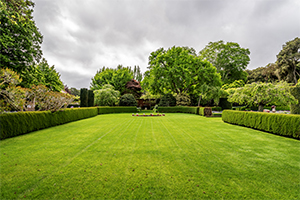With the UK lockdowns winding down, and the public venturing back out into the gardens and parks across the country, Historic Houses officially launches the 2021 Garden of the Year Award with eight spectacular nominees to vote for from around Britain.
The Garden of the Year Award, sponsored by Christie's auction house, has been celebrating Britain's extraordinary historic gardens since 1984. The award is voted on by the general public and by Historic Houses members, with almost twelve thousand votes cast in the 2020 award, given to Mapperton Gardens in Dorset.
This year, following the challenges of Covid-19 and with the successful rollout of UK vaccines, the eight nominated gardens are looking to bounce back strongly, and will be using the award to raise their profile in what appears to be the most competitive year yet.
The nominees for the 2021 award, which you can vote for on the Historic Houses website here, are:
Doddington Place Garden in Kent: Doddington Place is surrounded by wooded countryside in an area of outstanding natural beauty on the North Downs. The landscaped gardens, recognised of being of historical importance by Historic England, are set in the grounds of an imposing Victorian mansion and cover ten acres. Read about them here.
Gordon Castle Walled Garden in Moray: A hidden gem situated between the River Spey and the Moray Coast, our Walled Garden is one of Scotland’s best kept secrets. At almost eight acres in size it is one of the oldest and largest kitchen gardens in Britain and has been lovingly restored to its former glory with a modern design by world famous designer Arne Maynard. Read about them here.

Harewood House Gardens in Leeds: An Italianate Terrace, designed by Sir Charles Barry in the 1840s, stretches along the southern aspect of the House and provides stunning views over Yorkshire’s most beautiful landscape and lake. Crafted by Lancelot ‘Capability’ Brown, Harewood’s landscape encompasses over 1000 acres and represents one of Brown’s most famous vistas. Read about them here.
High Beeches Gardens in West Sussex: A hidden gem in the High Weald of Sussex, High Beeches is a botanical treasure trove planted with many rare trees and shrubs. There is much to see at every season: In spring the magnolias and camellias are under planted with swathes of daffodils and the woodland glades and vistas are, in early summer, carpeted with bluebells and filled with the colour and fragrance of the many rhododendrons and azaleas. Read about them here.
Kelmarsh Hall Gardens in Northampton: The Hall is surrounded by its working estate, grazing parklands and Grace II listed gardens. Kelmarsh boasts a distinctive Walled Garden, Sunken Garden, topiary and rose gardens, woodlands, lake and herbaceous borders – all designed principally by Nancy Lancaster, with Norah Lindsay and landscape architect Geoffrey Jellicoe. Read about them here.
Lowther Castle Gardens in Cumbria: The scale and beauty of the spectacular ruin that is Lowther Castle are reflected in the scope and setting of its 130-acre gardens. Here the past and present jostle for space. The Gardens were first formally laid out in the 17th century by the first Viscount, Sir John Lowther, a profound thinker and – significantly for the gardens – a committed vegetarian. Read about them here.
Penshurst Place Gardens in Kent: Surrounded by 11 acres of walled formal gardens and housing one of the few surviving medieval Baronial Halls in England, Penshurst Place is an historical gem in the Weald of Kent countryside. The stately home and gardens were once used as a hunting lodge for King Henry VIII, and now feature beautiful staterooms and grounds that are frequently showcased in popular TV and film productions. Read about them here.
Riverhill Gardens in Kent: 170 years of continual planting by six generations of the same family has created a rich and valuable plant collection for visitors to enjoy at Riverhill. The gardens are an intriguing mix of historic and traditional planting, with contemporary and quirky twists, making it a fascinating ‘must visit’ garden for families and garden lovers alike. Read about them here.
Ben Cowell, Director General of Historic Houses, said:
"We are a nation of garden lovers. The experience of lockdown has only made us appreciate the wonders of the garden even more. This is true whether we are lucky enough to tend a garden of our own, or simply enjoy visiting professionally maintained gardens to appreciate the work of talented gardening teams.
Every year, we hold a vote in a competition to find the UK’s greatest garden. The eight gardens in our shortlist represent the very finest gardens open to the public across the country. They range from Nancy Lancaster’s creation at Kelmarsh Hall in Northamptonshire, to Gordon Castle on the east coast of Scotland, to the gardens of Lowther Castle in the Lake District. Also included are Charles Barry’s ornate terraces at Harewood in Yorkshire, set within in a landscape created by ‘Capability’ Brown, the botanical treasure trove of colour and arboreal delight at High Beeches in East Sussex, and no fewer than three gardens from Kent, the Garden of England.
We are proud to have run the Garden of the Year award annually since 1984 with the support of Christie’s. Every year the race to the title is hard-fought, and this year’s shortlist is no exception. Please do cast your vote, and show your support for these wonderful gardens and the talented gardeners who brought them to life."
Voting for the award closes on 30 September 2021, with the winning garden announced at the Historic Houses AGM in November.


